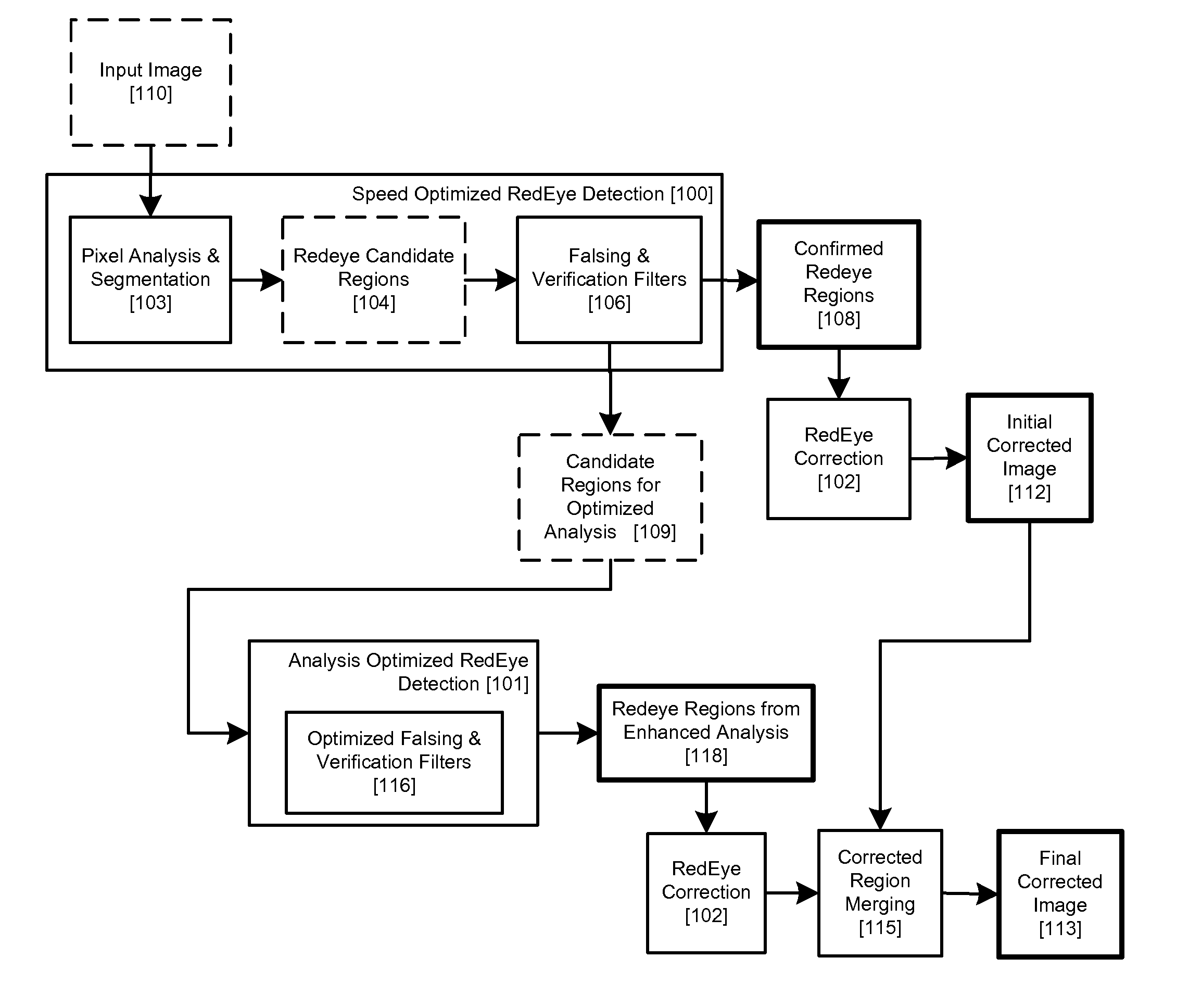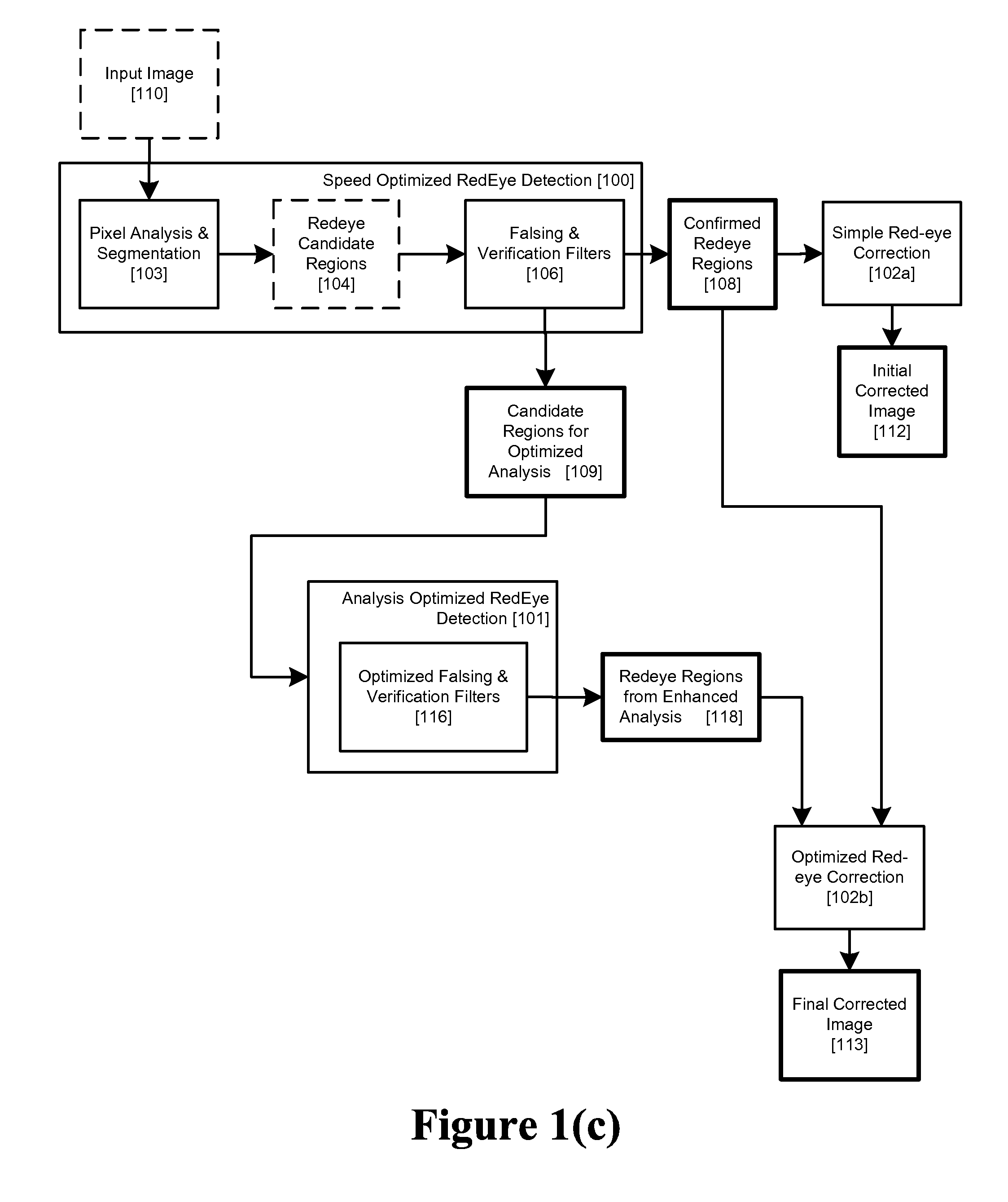[0054]In the embodiments above, the speed optimized redeye detection 100 is preferably applied to a sub-sampled input image. The confirmed redeye regions 108 from this speed optimized redeye detection 100 are passed to a redeye correction module 102 / 102a. The corrected redeye image 112 can be displayed on a low-resolution viewing screen of a
digital camera immediately after the
image acquisition process providing the user with a redeye corrected image almost instantly. However, although this initial corrected image 112 may be adequately corrected, for example, where it is a portrait-style image in which a face occupies most of an image or where large
high probability red-eye regions exist, it may not be adequately corrected for images including a large groups of persons, where the candidate redeye regions are smaller or less certain. Accordingly, the second analysis optimized redeye filtering process 101 is implemented after
image acquisition but prior to final image 113 display on a larger viewer, or image printing. We remark that one
advantage of the present invention is that the analysis optimized redeye detection 101 and correction 102 processes may be delayed until such
high resolution viewing or printing is desired by the
end user.
[0055]It should be noted that in the embodiments of FIGS. 2(a) and 2(b), the sub-sampled versions of the main image or well as uncorrected full size versions of the main image may be provided directly from main image acquisition device hardware 402 rather than needing to explicitly sub-sample a decoded full size main image.
[0056]As in the case, of FIG. 1(c), it will be seen that
image correction need not be performed on images within the acquisition chain and can in fact be performed in the background on acquired images for which speed optimised redeye detection has been performed in the acquisition chain. This is advantageous in many image acquisition appliances where
image compression is often implemented in hardware as part of the main image acquisition chain 401. In this embodiment, only the detection process is actually performed in the acquisition chain. A speed optimized correction or a full analysis optimized redeye filter may be subsequently selected in playback mode either based on a predetermined setting within the camera, or on a user selection at the time of image playback / viewing.
[0057]In the embodiment of FIG. 3(a), an acquired raw image 402 is partially processed 404 before being provided to DCT compression block 408-1. This block essentially provides a sub-sampled version of the acquired image and, although not shown, this can be provided to the image store 410 as explained above. A speed optimized redeye
detector 428 is then applied to the partially compressed DCT block image and DCT red-eye candidate regions both corrected and suspected uncorrected regions are output for storage in the store 410. An
advantage of applying speed optimised correction at DCT
block level, rather than at the pixel level, is that the need for an explicit image subsampling step is avoided, yet the benefits of applying redeye analysis to a sub-sampled image as detailed in the prior art cited herein are retained.
[0058]The regions output by the DCT prefilter 428, incorporated in the main image acquisition chain 401, can advantageously allow much of the DCT block
stream to be bypassed without being processed when an image is subsequently corrected by a filter such as a background filter module 426. This allows either much faster or more detailed analysis and filtering of the DCT blocks which are determined to require
processing by an analysis optimized redeye filter 406. Those skilled in the art will realize that further embodiments are possible which separate aspects of both the DCT prefilter and the otherwise conventional type redeye filter 406 between the main image acquisition chain, 401 and a background redeye detection and correction process 426.
[0059]FIG. 3(b) shows in more detail the operation of the redeye DCT prefilter 428. This particular example illustrates how the DCT prefilter can integrate with the main image acquisition, processing and compression chain, 402, 404 and 408 of FIG. 3(a). The DCT image to be filtered is first loaded into memory 902 after which the main DCT prefilter 428 is applied. This has three main steps: firstly the DCT blocks of the image are scanned 904 and the relevant DCT coefficients are extracted. Depending on the sophistication of the filter, only the DC components of each DCT block may be utilized in the subsequent analysis. Alternatively, some of the
AC components may be extracted in order to allow some texture or sharpness / blur determination as part of the prefilter operation.
 Login to View More
Login to View More  Login to View More
Login to View More 


